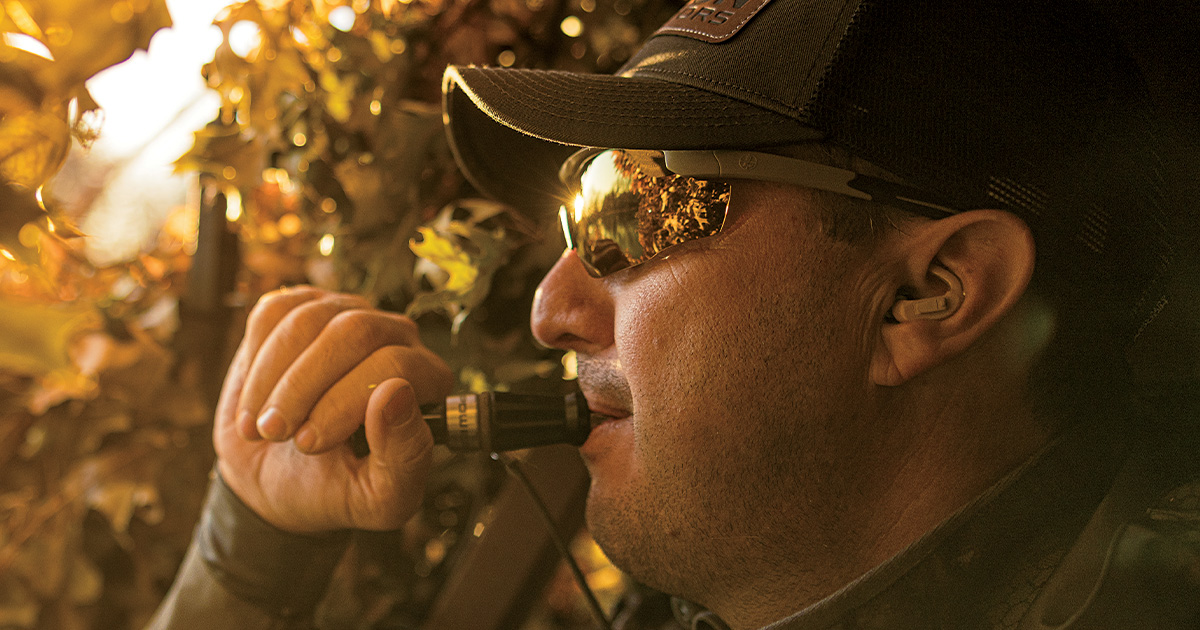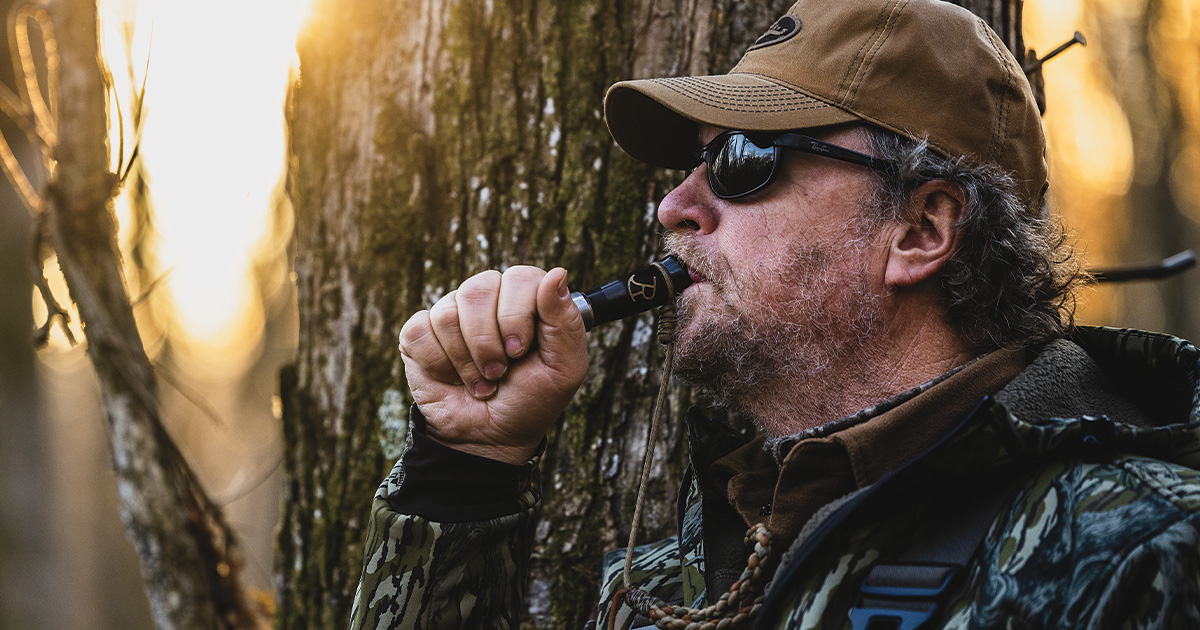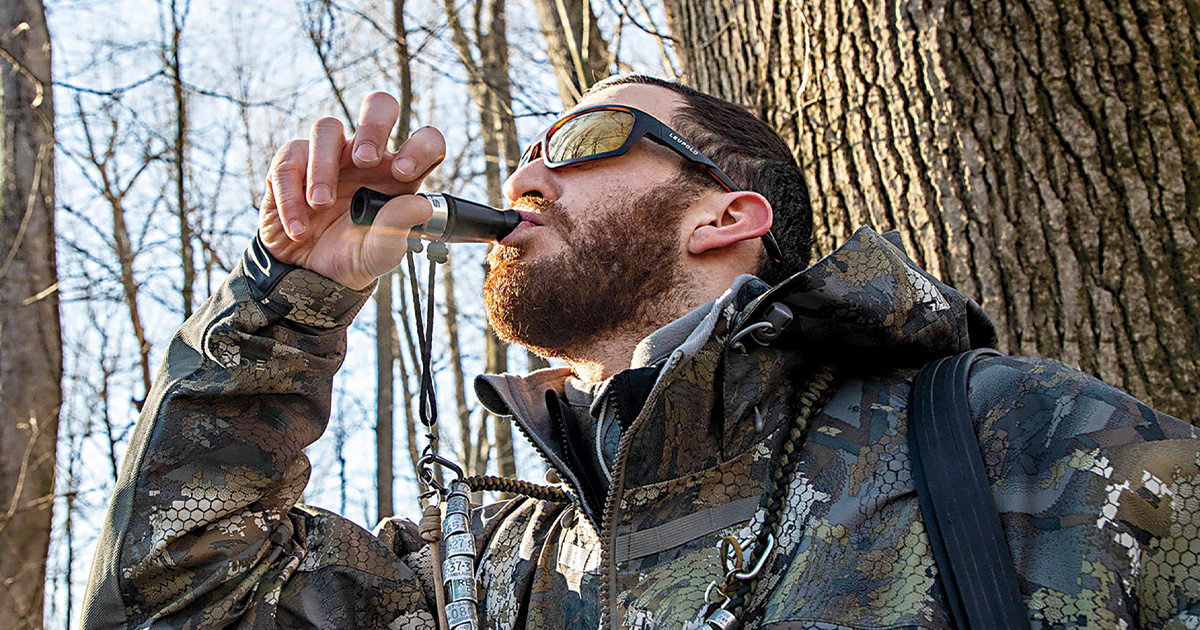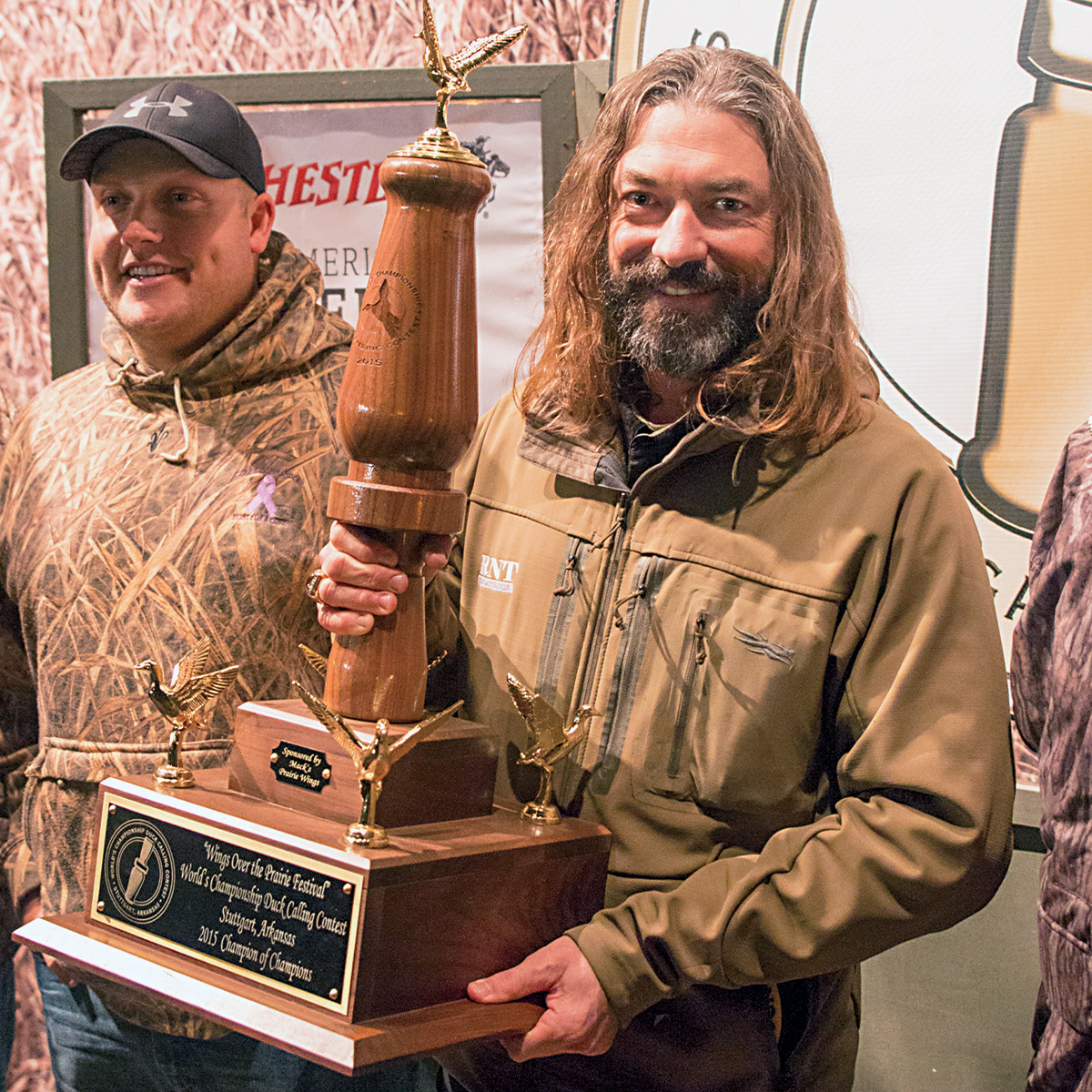Calling Clinic
These elite callers can help you take your skills to the next level
These elite callers can help you take your skills to the next level


World champion caller Kelley Powers says that great calling begins with a mastery of the fundamentals, which include holding the call properly, bringing hot air up from your lungs, and listening to real ducks.
Most of us have multiple calls dangling from our lanyards. And most of us are happy when we blow one of these calls and see the ducks react in a positive way. But then there are those times when the birds don’t react at all or, even worse, head in the opposite direction. We often write off this behavior, blaming it on call-shy birds, unfavorable weather, or a novice caller in the blind. This is where we differ from the true experts. These superstars of the calling world are skilled at putting air through a duck call, but, perhaps even more important, they are masters at reading duck behavior and knowing how to make the adjustments needed to adapt to any situation. Here, five of the country’s most elite callers share their secrets for elevating your calling game and putting more ducks over your decoys.
Kelley Powers is a world champion Canada goose caller, and he knows his way around a duck call as well. Decades of experience calling ducks and geese have earned him elite status, and he’s always happy to help others improve their skills. His advice to hunters at any level is to master the basics before moving on to more advanced techniques.
“Everything revolves around the basic quack and then advances from there. So we want to start with the basics of pushing air into the call. It sounds simple, but making sure that you’re blowing hot air into the call is extremely important,” Powers explains. “When you bring hot air up from your lungs and blow it onto a mirror, the mirror will fog. If you want to find out if you’re blowing a duck call correctly, stand in front of the mirror and blow onto it. If the mirror doesn’t fog, you’re not putting air into the call the correct way.”
Powers explains that once you know how to hold a call correctly—the small end of the call should fit into the webbing between your thumb and index finger—and you learn how to put air into the call correctly, the rest is learning how to make the correct sounds. “We can teach you everything you need to know about calling, but you need to learn how to sound like a duck by listening to ducks,” he says. “Go to the source. Go to a refuge or even a park and listen to live birds. Spend time listening to how these ducks communicate. That’s what calling is—communication.”

Beau Brooks blows loud, fast, five-note hail calls to break down high-flying ducks along Washington's Columbia River. Once the birds break, he switches to a hard feeding chatter. He uses a cutdown call, which is especially loud and raspy, to help him stand out from the competition.
The hail call, or highball, is an institution among waterfowlers in many parts of the country, especially in areas with big waters. Places like Tennessee’s famed Reelfoot Lake are known for the loud, long hail calls produced by hunters blowing thunderous metal-reed calls. The saying “you can’t teach an old dog new tricks” may be true, but as duck calls change over time, there are some new dogs using old tricks.
Beau Brooks, digital marketing specialist for Higdon Outdoors, grew up hunting the Columbia River in Washington, a landscape known for large numbers of ducks using large expanses of marshes, rivers, and fields. “Any given day, we are dealing with 50,000 to 100,000 ducks coming down the river after feeding all morning, and you’re pleading to get their attention,” he says. “We’ve always used competition-style hail calls, but recently I have switched to a cutdown call that really cracks and grabs their attention.”
Brooks explains that very few hunters in the Pacific Northwest use the cutdown J-frame-style calls that are more common in Arkansas and other parts of the Mississippi Alluvial Valley. He feels this gives him an edge, even when the wind is howling and other hunters have set up nearby. “I’m using a quick, five-note call and relying more on forward pressure than back pressure, but still channeling air, like a quick crack,” Brooks says. “This fast-paced quack, quack, quack, quack, quack is high volume. It outcompetes other callers and forces these ducks to pay attention.”
There are only two other people he knows in the area who call like this. They are friends who have watched him break down ducks from high in the sky. “I can hit that quick, raspy five-note call and as soon as they break, I hit them with a hard chatter and guide them right into the decoys,” he says.

Jim Ronquest says the key to an effective feeding call is knowing how to modify volume and pitch based on how the ducks are reading.
Expert callers use the feeding call in a variety of ways to get ducks to put their feet down. While there are different iterations of this call, it’s the inflection and tone that make the difference. Simple tu-ka tu-ka tu-ka tu-ka sounds can take on countless variations when performed by an expert caller.
Jim Ronquest, a world duck calling champion and vice president of development for Drake Waterfowl, advises hunters to change the volume and pitch of their feeding calls based on the reactions of working ducks. “Modifying your feeding call is like modifying your voice when you’re talking to someone,” he says. “If I see you across a crowded airport terminal I might shout, ‘Hey, man!’ as I pass by. If you’re about to step on a four-foot-long cottonmouth that’s as big around as a beer can, I’ll say ‘Hey, man!’ but I’ll whisper it softly, quickly, and sternly. In both cases, I’m saying the same thing, just putting a different inflection in my voice to communicate something very different.”
Ronquest transitions from a soft, purring feeding call to a multi-faceted hard-breaking feeding call combined with single quacks—something he refers to as a hard chatter. Technically, it’s all the same notes and sounds, but when air pressure changes, the inflection changes. “What I am looking for when I hit a hard chatter, or a breaking chatter, is that slight dip in the wings or tail feathers,” Ronquest adds. “If they dip those wings, I’ll stay on them. I’ve had days where I needed to back off to a softer chatter or even back off all together, but I’ve also worked ducks all the way to the water with a loud, hard chatter. Changing that inflection in the call can make a big difference in how ducks react.”

Some days, a little calling can go a long way. Brook Richard cautions waterfowlers to avoid overcalling especially in team-calling situations.
Effective team calling is the art of understanding another caller’s abilities, cadences, and aggressiveness to create a realistic duck-filled chorus. The foundation of this approach is communication—with the ducks and with the other callers.
One of Powers’s regular hunting partners is Brook Richard, director of marketing for Higdon Outdoors. Because they are familiar with each other’s styles, these two experts combine for a true one-two punch. “Team calling really comes into play on windy days, when you need volume,” Richard says. “There’s also a fine line between effective team calling and overcalling. Be aware of your conditions and surroundings. If Kelley is calling to some high ducks, I may help him break them down, but then I’m holding off on the call. If I see the ducks start to drift or lose interest, that’s when I might jump in to help. Knowing what your hunting partner is doing, and reacting to that, is an important part of team calling.”
As all waterfowl hunters know, every day is different when it comes to weather and ducks. Experience will dictate how team calling should be applied. “We have some of those days when it is cold, there’s a big north wind, and I tell everyone in the blind, ‘All right, let’s stay on these ducks until they are on the water.’ That’s when team calling can really improve your situation,” Powers says. “However, I have a saying that comes up a lot in the duck blind: ‘more is always more, and more is not always better.’”

John Stephens was named champion of champions in 2015. He says that variation, intensity, and power are the marks of a good caller, whether you are trying to impress the ducks or the judges.
For most hunters, working ducks into the decoys with a call is the end goal, but there’s another level to this game—competition calling. The Main Street stage in Stuttgart, Arkansas, is the site of the annual Super Bowl of competitive duck calling. Becoming a successful competitor takes a level of preparation and expertise that very few callers even attempt, but those who put in thousands of hours of practice become elite practitioners of air control, hail calls, and feed chuckles. There’s no better source for advice about competition calling than John Stephens, president of Rich-N-Tone Calls, three-time world duck calling champion, and champion of champions.
“The first thing I would recommend to someone who is interested in competition calling is to go to contests,” Stephens says. “See what the top callers do, whether that’s on stage or on YouTube, and then develop your own style.” Stephens points out that competition calling is very different from hunting—rather than attracting ducks, you’re trying to impress the judges.
“One thing I’ve always done is try to create interest in my calling using a lot of variation, intensity, and power,” he says. “There are ways to add realism into the routine, but strong chuckles and chatters and using your throat to control air can make your calling stand out.”
Standing on the Main Street stage when the spotlight is on and the crowd is surging takes confidence, and Stephens explains that being prepared for those moments is all about training. “I’d say that working up your control by calling at least 10 minutes every day is a good start. However, you could blow your calls all day and still not put as much air into that call as you will in a routine,” he says. “As a competition gets closer, I’ll blow as many as 10 routines a day to get that air control down. The last thing I tell people is to record themselves, which is a lot easier to do these days compared to when I started. Recording yourself allows you to get an understanding of what you’re doing right or wrong and to become more versatile.”
And versatility will improve your success, whether you are blowing a call on stage for the judges or calling ducks in the marsh.
Ducks Unlimited uses cookies to enhance your browsing experience, optimize site functionality, analyze traffic, and deliver personalized advertising through third parties. By continuing to use this site, you agree to our use of cookies. View Privacy Policy